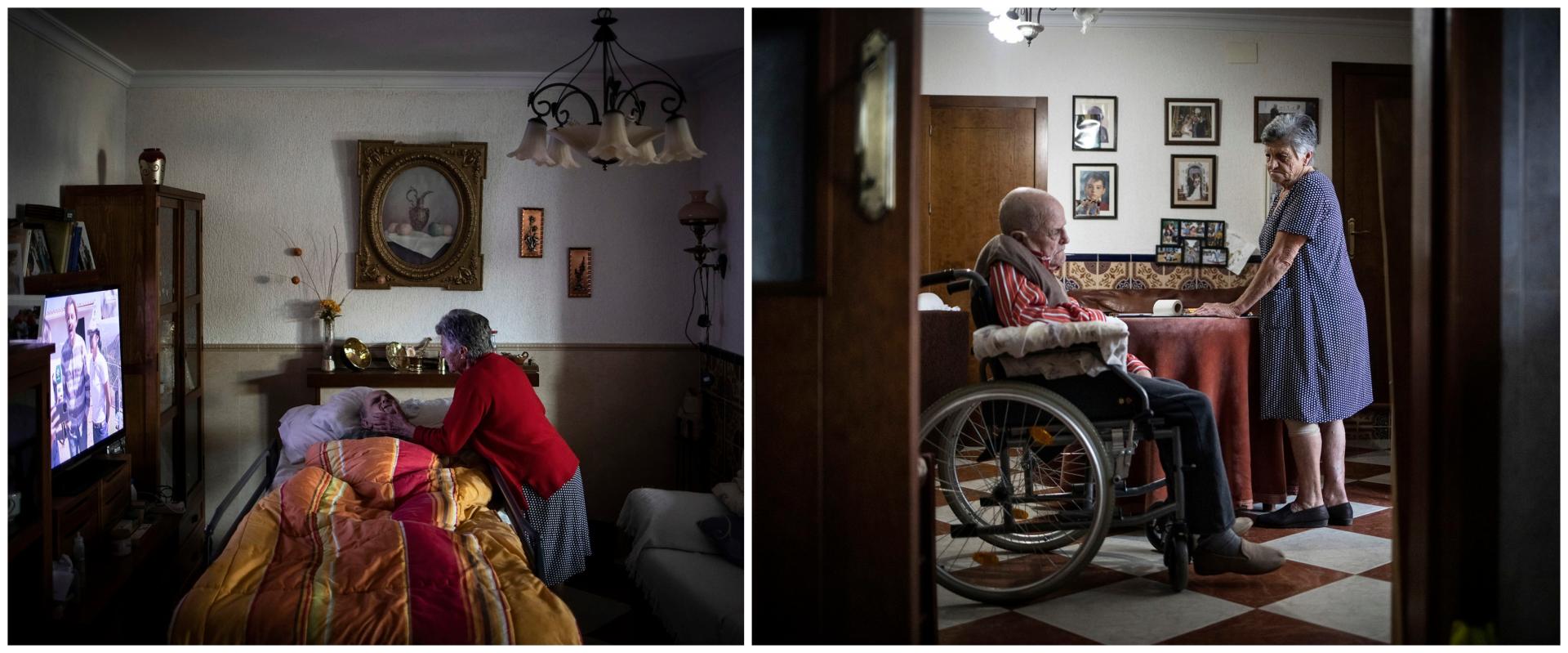As life expectancy increases in every corner of the world, so, too, does the responsibility of caring for an aging population. Among the countries projected to have the oldest populations by 2050 is Spain, where the average age will exceed fifty-five years old. More than two million dependents in that country require daily home care from family members, 90 percent of whom are women. Access to care facilities is limited by availability and cost, while in some communities, resorting to such facilities is stigmatized as callous or neglectful.
More than three hundred thousand people in Spain are currently on a waiting list for government assistance to help with in-home care, but processing these files can take years. Public services, when they do arrive, are often insufficient. Caregivers can be forced to abandon their careers: 75 percent of Spanish women have, at some point, reduced their work hours to devote themselves to care work. This affects not only their professional lives, but also their future financial security.
The work also affects caregivers’ physical and mental health. Faced with the financial, emotional, and physical stresses of their responsibilities, they are prone to burnout, anxiety, insomnia, fatigue, and depression. But they are still determined to do all they can to ensure that their loved ones can live with dignity. This collection of photographs highlights women across Spain who have oriented their lives toward this goal. Daughters, wives, mothers, and sisters, they’re united by one common reality: living to care.

Above: Sonia has taken on more and more caring tasks in her family home as her seventy-six-year-old mother Antonia’s Alzheimer’s has progressed. She hurries from her job at the Andalucía Emprende office to her parents’ house several times a day, finishing her work in the evenings. Her father, José, who never leaves Antonia’s side, helps with her care. Although the work is a huge strain, Sonia has not considered the idea of a nursing home.

Above: Emilia has been looking after her mother, Ana, for three years. Ana is not eligible for public-dependency benefits, so her care and costs fall exclusively on Emilia, who has adapted her career to allow for teleworking in order to remain with her mother.
“My mother abandoned me when I was a child, but when I saw her situation in Romania, alone and sick, I didn’t hesitate to bring her home with me. What else could I do? It is only now that she is no longer able to remember anything or to speak that I am forgiving and healing from all this pain. Now she even gives me a smile sometimes, something that never happened when her mind was fine. Caring for her has taught me forgiveness, real love, and patience—but most of all, to reconcile with her.”

Above: Ángeles and her husband Narciso have been caring for their daughter Soraya since she was born fifty years ago. Soraya has the mental capacity of a six-year-old, with a passion for cuddly toys and coloring books. Under Ángeles’s dedicated care, she has learned to read and write.
“My daughter cannot be alone. She depends on us for everything. I’m afraid for the future—we are old, and although we will pull this off while we can, I don’t want to leave this burden to my other children. This is ours, no one else’s.”

Above: Dolores has been caring for her husband, Santiago, for eight years, following his severe stroke. Home-help services have assigned her twenty-three minutes of aid from Monday to Friday, which she uses to lift and move Santiago during his morning bath. He is also assigned to a local day center, which provides care from 9:00 a.m. to 3:00 p.m. From that time on, all the care of her husband falls into her hands.
“The house is the best place for my husband. I can hardly lift anything because of the arthrosis in my bones, but I can manage. This is for me. Even though he doesn’t talk or anything, I know that no one will look after him like here.”

Above: Francisco Javier, now twenty years old, suffers from a rare, hereditary disease that affects only four hundred people in Spain. Since his birth, his mother Herminia (Hermi) has devoted all her time to him. The family recently closed the grocery shop they ran in the village because it was impossible to look after it while remaining alert to Francisco’s epileptic crises and medical appointments. The Dependency Law has granted him the maximum degree of dependency, which translates to a monthly allowance of 380€—but this is not enough to cover the expensive medicines and treatments he needs, and it requires giving up any allotted hours from the home-help service. Hermi is helped by her twenty-four-year-old daughter, Ainhoa, who is sure that in the future, she will look after her brother. Hermi suffers from several herniated discs and early bone deterioration as a result of carrying her son’s weight for years.
“I cannot conceive of life without my son. My whole life is him, and my struggle is to improve his quality of life. I want to be with him, even in these conditions. He is the person who has taught me the most. In reality, I am the one who depends on him to live.”
